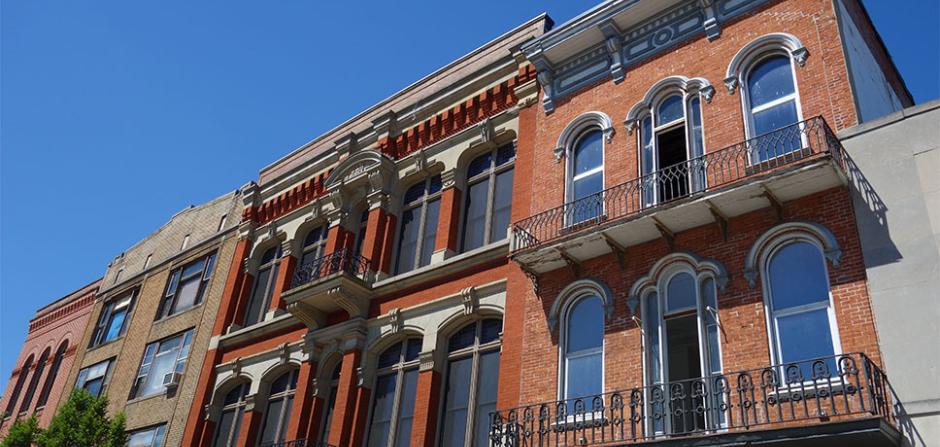 Press release from Ohio History Connection.
This program is a partnership between SIEDC, Tiffin Historic Trust and Seneca Regional Chamber of Commerce and Visitor Services.
Press release from Ohio History Connection.
This program is a partnership between SIEDC, Tiffin Historic Trust and Seneca Regional Chamber of Commerce and Visitor Services.
(COLUMBUS, OH)— The Ohio History Connection’s State Historic Preservation Office, the Seneca Industrial and Economic Development Corp., the Tiffin Historic Trust and the Seneca Regional Chamber of Commerce and Visitors Center will sponsor a Building Doctor Clinic for old-building owners in Tiffin, Ohio on July 21 and 22, 2016.
The clinic features Building Doctors Justin Cook and Richard Jarvis of the Ohio History Connection’s State Historic Preservation Office. It begins with a free seminar on Thursday evening, July 21, from 7-9 p.m. at the Tiffin–Seneca Public Library’s Frost Kalnow Room at 77 Jefferson Street in Tiffin. The seminar is open to the public and will feature guidelines for renovation projects and ways to solve some of the most common problems of buildings dating from 1800 to 1955.
On Friday, July 22 from 9 a.m.-3 p.m., the Building Doctors will visit pre-1955 buildings within five miles of Tiffin, advising owners on specific technical problems by appointment. The “doctors” examine all kinds of older buildings. Some of the things that typically call for an on-site examination include persistent peeling paint or flaking plaster, a wet basement or deteriorating masonry and plans for additions.
Justin Cook, Technical Preservation Services Manager for the Ohio History Connection’s State Historic Preservation Office, has a bachelor’s degree in classics from the University of Pittsburgh and a master’s degree in historic preservation from the University of Vermont, with post-baccalaureate studies in History and Urban and Regional Planning. He reviews applications for federal and state historic rehabilitation tax credits.
Richard Jarvis is Technical Preservation Services Manager for the Ohio History Connection’s State Historic Preservation Office. He holds a master’s degree in Conservation Studies (Historic Buildings) from The University of York (UK), a bachelor’s degree in Business Administration from High Point University and an associate’s degree in Architectural Technology from Guilford Technical Community College. He reviews applications for federal and state historic rehabilitation tax credits.
The seminar and on-site consultations with the Building Doctors are free with advance registration. To register, visit
www.building-doctor.org or call 800.499.2470 or 614.298.2000. You can also contact Amy Reinhart at 419.447.3831.
The Building Doctor program is made possible in part by a grant from the U.S. Department of the Interior’s Historic Preservation Fund, administered by the Ohio History Connection’s State Historic Preservation Office. Each clinic is also made possible by support from local cosponsors.
The Ohio History Connection’s State Historic Preservation Office
The Ohio History Connection’s State Historic Preservation Office is Ohio’s official historic preservation agency. It identifies historic places in Ohio, nominates properties to the National Register of Historic Places, reviews federally-assisted projects for effects on historic, architectural, and archaeological resources in Ohio, consults on conservation of older buildings and sites and offers educational programs and publications.
Ohio Historical Society is now Ohio History Connection
On May 24, 2014, the Ohio Historical Society changed its name to the
Ohio History Connection. Established in 1885, this nonprofit organization provides a wide array of statewide services and programs related to collecting, preserving and interpreting Ohio’s history, archaeology and natural history through more than 50 sites and museums across Ohio, including its flagship museum, the Ohio History Center in Columbus. For more information about programs and events, call 800.686.6124 or go online at
www.ohiohistory.org.
Prescriptions from the Building Doctors:
Do's:
- Check your roof and attic or upper stories for leaks at least every six months. Look for separations, bulges, cracks, and signs of moisture. It’s important to check your roof regularly. A sound roof is the key to preventing many problems which can occur below.
- Inspect your gutters and downspouts during a hard rain to see that they’re working properly. Keep them clean and free of leaves and obstructions which may clog them. Make sure water from downspouts is directed away from the foundation.
- Open your basement windows in the dry season to let air circulate. Feel basement walls for dampness. A musty odor indicates a high moisture level in the basement. Check for proper ventilation and dehumidification. Be certain that air circulates freely and isn’t blocked by materials stored against the wall.
- Look for loose or damaged siding. Note any areas of paint failure. Check gaps between boards. Gaps smaller than a quarter-inch will help ventilate the wall cavity; larger gaps may admit rainwater.
- Caulk gaps where window and door frames meet masonry or wood openings to prevent water from entering wall cavities of frame buildings or masonry of bearing-wall structures.
- Examine painted surfaces for signs of peeling, cracking and alligatoring. Look for clues to original painting techniques and colors. A common way to examine hidden layers of paint is to carefully sand a small area in a location where it would not have weathered or been in direct sunlight, exposing the individual layers.
- Assess the condition of all exterior features, particularly those of significance, such as porches, brackets and other decorative trim.
- Attend the Building Doctor Clinic.
Don'ts:
- Don’t use abrasive methods to clean brick or masonry. They can cause irreparable harm. Sandblasting, for example, removes the hard outer surface of the brick, exposing its softer core to the elements, and damages other kinds of masonry and wood, too. Avoid all techniques for cleaning masonry or wood that involves blasting or high pressure.
- Don’t use water-repellent coatings on masonry. They can trap moisture inside instead of letting it pass freely in and out as it normally would. When trapped moisture freezes, it expands, often forcing the surface of the brick or stone to flake or spall.
- Never seal basement windows shut. You’ll trap moist air inside and prevent proper air circulation, which can lead to a damp basement.
- Don’t plant bushes or vegetation close to the foundation. They prevent sunlight from reaching the ground, allowing moisture to accumulate there.
- Don’t use blown-in insulation unless you install a vapor barrier, too. Without the vapor barrier, moisture can accumulate, saturating the insulation and damaging your wall.
- Don’t leave unused gas pipes connected or live ends uncapped. Have gas lines professionally inspected. You can prevent a tragedy and save yourself a great deal of money.
- Don’t allow bare wires to remain exposed. Have old wiring professionally inspected.
- Don’t forget to give your building a thorough check-up every six months to ensure that it has a clean bill of health.

